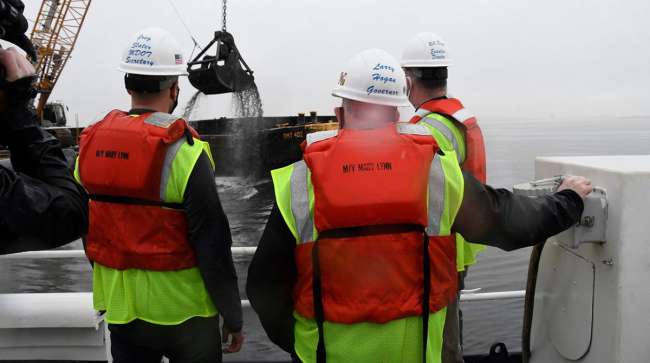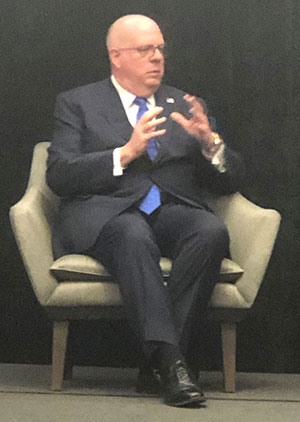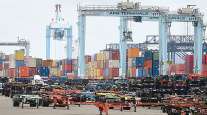Senior Reporter
Port Leaders Say They're Ready to Spend Infrastructure Funds

[Stay on top of transportation news: Get TTNews in your inbox.]
With the largest infusion of direct federal infrastructure spending set to begin, port leaders from around the country say they’re ready to begin rebuilding and upgrading their facilities to keep up with a record number of cargo containers moving through ports.
That was the main message at the annual legislative conference of the American Association of Port Authorities in Washington, March 29-31.
The new bipartisan infrastructure law calls for spending $17.2 billion on port redevelopment programs. And even before the federal dollars began flowing, several states, including Maryland, California, South Carolina and Georgia, began spending their own money on key projects, adding terminals, deepening shipping lanes and installing new cranes to handle the largest Neopanamax ships capable of carrying 14,000-plus containers.

Maryland Gov. Larry Hogan by Dan Ronan/Transport Topics
Maryland Gov. Larry Hogan pointed to two major infrastructure projects taking place at the Port of Baltimore that will significantly increase business.
The port recently finished a dredging project on the Chesapeake Bay Navigation Channel at the Seagirt Marine Terminal, deepening it to 50 feet and allowing for simultaneous unloading of two Neopanamax ships.
Now under construction, and set to be complete in 2024, is a $466 million upgrade of the 126-year-old Howard Street tunnel that is being expanded to handle double-stacked containers from the Class I railroad CSX into and out of the port.
“This will clear a decadeslong blockage for the Port of Baltimore and break a major East Coast bottleneck,” Hogan said. “This is expected to dramatically increase business at the Port of Baltimore by 160,000 containers annually and it’s a job creator for our state, it will generate nearly 14,000 jobs for our state.”
The tunnel’s current clearance is 18 inches too short to handle the larger boxes, and while keeping the tunnel operational, the workers are lowering the track to create additional room. Along with the tunnel reconstruction, work will be done on 22 bridges between Baltimore and Philadelphia to allow larger rail containers.
Throughout his more than seven years as governor, Hogan championed the use of 3PLs, public-private partnership programs, to upgrade infrastructure. The agreement with CSX to upgrade the Howard Street tunnel is being split, with Maryland paying more than $200 million, the federal government nearly $130 million, $113 million from CSX and $22.5 million from Pennsylvania.
A real Maryland flavor! During today's @AAPA_Seaports Legislative Summit, Port Exec Dir @WilliamPDoyle moderated a discussion with @GovLarryHogan on benefits, econ impact of the infrastructure stimulus. Gov is a huge supporter of the port industry and its role as a job creator! pic.twitter.com/n9Wt6DOhRg — Port of Baltimore (@portofbalt) March 30, 2022
“We are proud to have one of the most aggressive implementation strategies in the country,” Hogan said. “Years and decades from now, I am confident we will be able to look back on this time as a ‘golden age’ of infrastructure for our nation, when we overcame divisiveness and dysfunction and got this done for the American people.”
Federal Maritime Commission Chairman Daniel Maffei told port leaders while much of the nation has focused on challenges the ports and supply chain have faced during the last two years because of the COVID-19 pandemic, the day-to-day work at those facilities has gotten done as freight volumes have surged by in some cases double digits each month.
“There’s no question that the port infrastructure government program funds will help make a difference, maybe not tomorrow, but they are desperately needed,” Maffei said.
The former congressman from New York said he supports efforts now in Congress to increase the FMC’s enforcement authority to oversee shipping companies. During the pandemic, in part because of the dramatic rise in freight, the cost of transporting items overseas by cargo ship has significantly increased.
The Ocean Shipping Competition Reform Act was introduced in the Senate by Sen. Amy Klobuchar (D-Minn.) and she said it would “hold ocean carriers more accountable for anticompetitive behavior.”
The cost of moving goods continues to skyrocket. According to data March 11 from the international freight booking platform Freightos, shipping a container from Asia to the U.S. West Coast surged to $16,300, nearly triple what it was at the same time last year.
But Maffei says there’s a larger problem in that the amount of goods being shipped internationally far exceeds the current supply chain’s capacity to handle them.
Want more news? Listen to today's daily briefing above or go here for more info
“While I am in no way exonerating the carriers and their alliances for taking advantage of this situation to make money,” Maffei said, “it’s clear the post-COVID boom and demand for consumer goods has outstripped the supply of cargo capacity, both on the sea and in terms of trucks, trains and warehouses. But so far, it appears virtually all the container-carrying capacity is being utilized, less than 1% of the world’s fleet is idle.”
The White House has expressed support for Klobuchar’s legislation and added it backs language that would allow the FMC and Department of Justice to review applications for new alliances between global shipping companies for antitrust issues, and turn down those that are not in the public interest.
The House passed its version of the bill last December but it must be reconciled with a Senate version.




